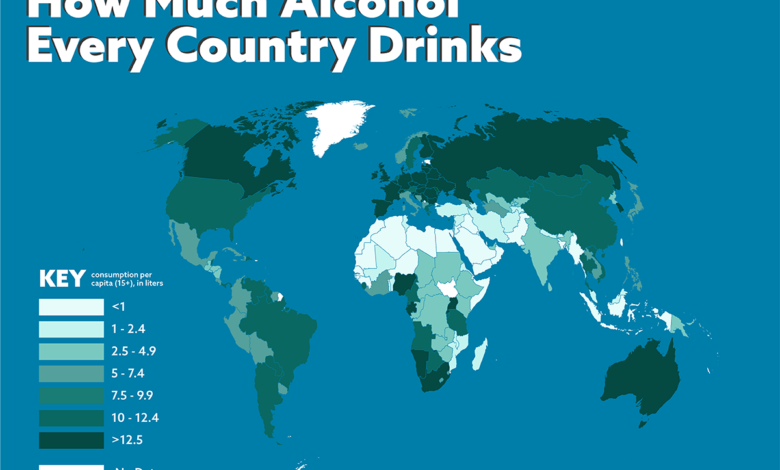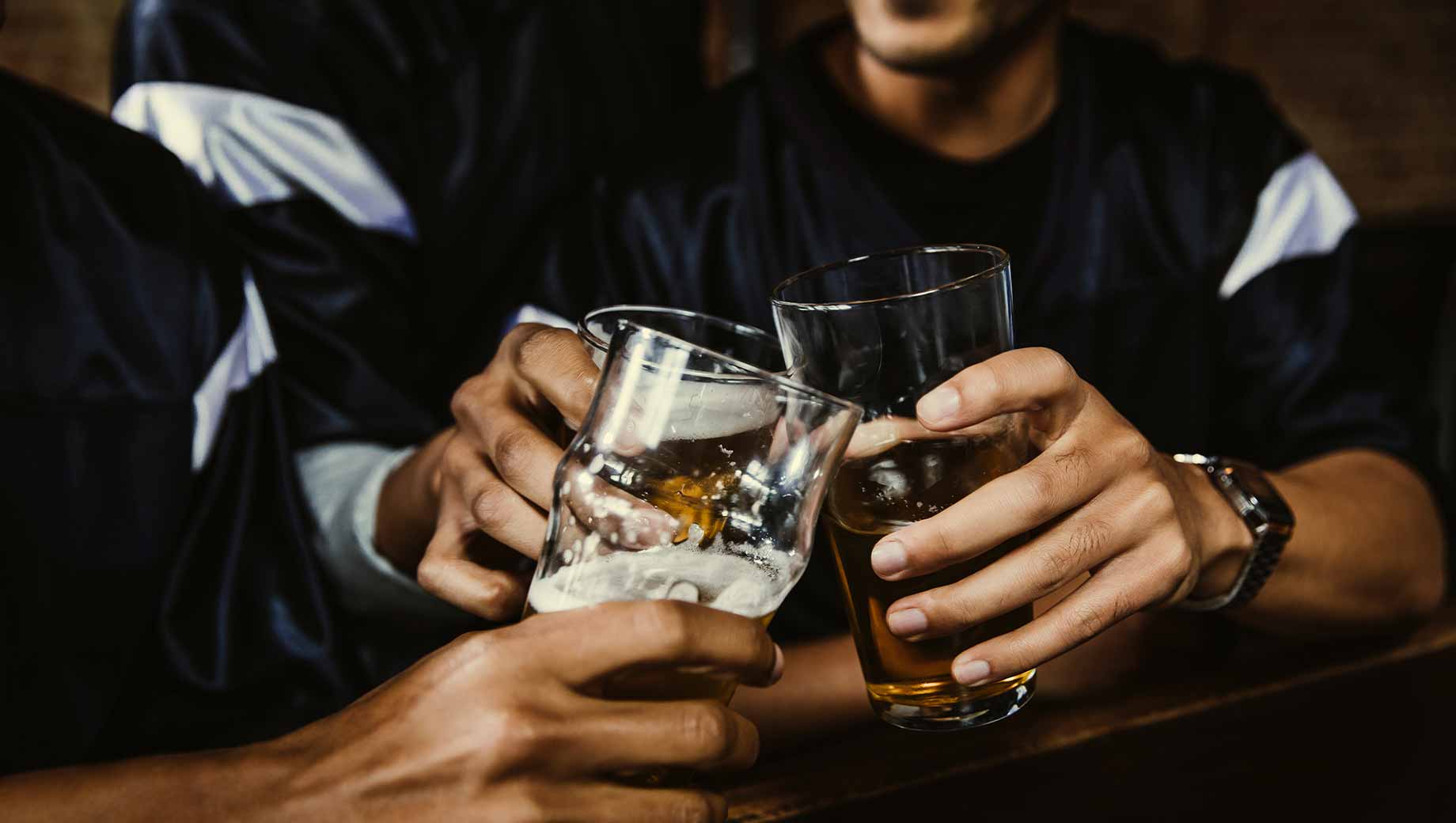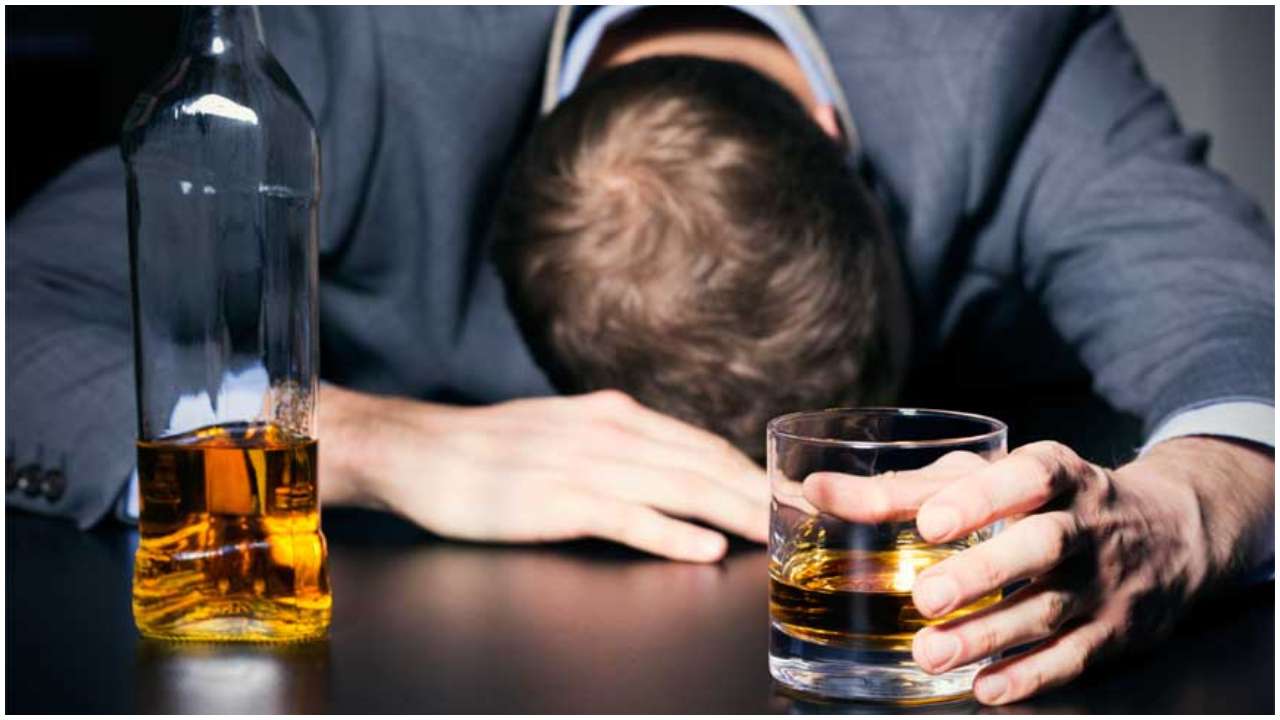Top 10 alcohol consumption countries; Alcohol consumption in India

Top 10 alcohol consumption countries; Alcohol consumption in India
A chemist defines “alcohol” as an organic substance with carbon, hydrogen, and oxygen bound in a certain configuration, such as ethanol (C2H6O). However, to the typical individual, “alcohol” refers to alcoholic beverages like wine, beer, whiskey, vodka, tequila, and others. Alcoholic beverages are a part of practically every culture on the planet, with the exception of those whose religion forbids them.
The fundamentals of alcoholic drinks
Fermentation is a process in which water, grains, vegetables, or fruits are combined with yeasts or bacteria, which eat the sugars in the food and generate ethanol and carbon dioxide. Beer and wine are both fermented alcoholic beverages. Hard alcohols, often known as “spirits” or “liquors,” such as whiskey, go through a second distillation process to eliminate part of the water, resulting in a greater alcohol content and more taste.
Alcohol is a controlled substance that is categorized as a depressant. Alcohol is commonly used to “loosen up” and arguably functions as a stimulant when used in small doses, such as one or two glasses of beer or wine. When eaten in bigger doses, however, depressive symptoms emerge, including delayed motor functions, sluggish response times, and muted or slurred speech.
Alcohol is regulated by laws that establish a minimum drinking age (usually 18 or 21, but this varies by country), restrict open alcohol carrying in public places, require liquor licenses for restaurants and stores, and prohibit driving while intoxicated (drunk driving).
What exactly is “a drink”?
A “drink” in the United States contains 0.6 ounces of pure alcohol. This nicely correlates to the average quantity of alcohol in the following common beverages:
-12 ounces of beer (one can)
-malt liquor (eight ounces)
-5 oz. wine (about one ordinary glass)
-1.5 ounces (one-shot) of distilled spirits or liquor that is 80-proof (40 percent alcohol content).
Alcoholism
Alcoholism is a chronic and widespread medical condition that affects millions of individuals worldwide. The term “alcoholism” is really a popular phrase for a sickness defined as “alcohol use disorder” in medical terms. Abuse and dependence on alcohol are the hallmarks of alcohol use disorder. A person may be diagnosed with alcohol-dependent disorder if they display any two of the following symptoms within a 12-month period, according to the Diagnostic and Statistical Manual of Mental Disorders, Fifth Edition (DSM-5).
Symptoms of an alcoholic dependency disorder (alcoholism)
Have there been moments in the last year when you drank more or for longer than you intended? Have you ever desired to cut down or stop drinking or attempted but failed to do so? Have you been drinking a lot lately? Or are you sick or recovering from additional side effects? Have you ever been so desperate for a drink that you couldn’t think of anything else to do?
Have you ever found that drinking — or being unwell from drinking — made it difficult to take care of your house or family? Or harmed your career prospects? Or perhaps there are issues at school? Have you continued to drink despite the fact that it was generating conflict with your family or friends? Have you given up or reduced your participation in things that were essential to you or brought you joy in order to drink? Or:

Have you ever been in a position during or after drinking that put you at risk (such as driving, swimming, using machinery, wandering in a dangerous location)
Have you continued to drink despite the fact that it was making you feel melancholy, worried, or aggravating another health issue? Or after a period of memory loss?
Do you have to drink a lot more than you used to obtain the desired effect? Or did you notice that your regular quantity of drinks had a considerably less impact than before?
Have you ever experienced withdrawal symptoms such as insomnia, shakiness, restlessness, nausea, sweating, a racing heart, or a seizure after the effects of alcohol had worn off? Or did you get a sensation of something that wasn’t there?
Alcoholism has many severity levels, which are determined by the number of symptoms experienced by a patient: 2-3 is mild, 4-5 is moderate, and six or more is considered severe. Counseling, drugs, and even medically assisted detoxification are all used to help people who have an alcohol dependence issue stop drinking safely.
Alcoholism and the consequences of binge drinking
Alcoholism is a chronic condition characterized by binge drinking and an obsession with the substance. Alcoholism rates differ by nation and do not always reflect alcoholic intake. Heavy drinking and binge drinking are examples of excessive drinking.
For women, heavy drinking is defined as eight or more drinks per week, while for men, it is defined as 15 or more drinks per week. Binge drinking is defined as consuming four or more drinks in a single event for women and five or more drinks in a single occasion for males.
Excessive alcohol use can result in a variety of health problems. The potentially harmful effects on the heart, such as increased blood pressure, stroke, arrhythmias, and cardiomyopathy, are arguably the most significant. Liver steatosis (fatty liver), alcoholic hepatitis, fibrosis, and cirrhosis can all be caused or exacerbated by alcohol.
Alcohol intake has also been related to cancers of the head and neck, the esophagus, the liver, the breast, and the colon. Finally, alcohol impairs judgment and impairs motor abilities, which can lead to dangerous accidents, especially while driving.
Alcohol use in different parts of the world
Each country’s alcohol consumption varies widely and is influenced by its laws, culture, and other factors. For all beer, wine, spirits, and other alcoholic drinks, the World Health Organization reported each country’s alcohol consumption in liters of pure alcohol. One handle of vodka (1.75 liters) has around 300 milliliters of pure alcohol, while a typical 12-ounce beer or 5-ounce glass of wine contains about 0.6 ounces (.0178 liters/17.8 ml) of pure alcohol.
The following are the top ten countries with the highest alcohol consumption (measured in liters of pure alcohol per capita):
1.Czechia – 14.26
2.Latvia – 13.19
3.Moldova – 12.85
4.Germany – 12.79
5.Lithuania – 12.78
6.Ireland – 12.75
7.Spain – 12.67
8.Uganda – 12.48
9.Bulgaria – 12.46
10.Luxembourg – 12.45
Czech nationals used the most alcohol per capita in 2019, according to the World Health Organization, with 14.26 liters of pure alcohol drunk per person. Latvia and Moldova come in second and third, with 13.19 and 12.85 points, respectively. There are 38 nations on the list (see table below) that consume more than 10 liters of pure alcohol per year. The vast majority of these nations are found in Europe.
In 2019, the average yearly intake of pure alcohol in the United States was 9.97 liters per person. However, this varied by state. This places the United States in 39th place globally, much above the global average of 5.8 liters. In the United States, the legal drinking age is 21 years old, and it is severely enforced in most places.
The following are the top ten countries with the lowest alcohol consumption (measured in liters of pure alcohol per capita):
Somalia, Bangladesh, Kuwait, Mauritania, Saudi Arabia (5-way tie) – 0.00
Afghanistan – 0.013
Libya – 0.027
Yemen – 0.034
Egypt – 0.14
Syrian Arab Republic – 0.19
Bhutan – 0.21
Indonesia – 0.22
Pakistan – 0.31
Djibouti – 0.36
Alcohol drinking is frowned upon by the Middle East’s leading religions, as seen by the region’s extremely low consumption statistics.
Do men or women consume more alcohol?
/cdn.vox-cdn.com/uploads/chorus_image/image/59499143/GettyImages_565954723.0.jpg)
In most nations, males consume at least three times the amount of alcohol consumed by women. Czechia’s combined average is 14.6 liters. However, women’s averages are 6.9 liters, and men’s averages are 22.0 liters (both of which are global highs). The discrepancy is significantly greater in certain nations. Men in Turkmenistan, for example, use 5.26 liters per year, more than five times the amount consumed by women (1.03 liters per year).
Alcohol dependency disorder by country
The prevalence of alcoholism varies a lot from one country to the next. While it would seem that rates of alcoholism would be strongly related to general alcohol consumption or potentially drinking age in each nation, this is not always the case.
Although consumption varies by state, the average yearly intake of pure alcohol in the United States is 8.7 liters or the equivalent to 29.0 handles (1,716.8 fluid ounces/50.75 liters) of vodka per person. This implies that, although ranking seventh on the list of nations with the highest rates of alcoholism, the United States ranks 38th in terms of alcohol consumption per capita.
The World Health Organization gathered the most latest statistics on alcoholism rates in each nation in 2016, recording the percentage of males and females 15 years and older with alcohol use disorders.
Alcohol consumption in India
Arunachal Pradesh has the largest proportion of males (53%) and women (24%) who use alcohol among all states.
According to the National Family Health Survey-5 (NFHS-5), 2019-21, alcohol use among men and women is greater in rural India than in urban India. In general, 1% of women aged 15 and above consume alcohol, compared to 19% of males in the same age range. Women make up 1.6 percent (rural) and 0.6 percent (urban), whereas males make up 19.9 percent and 16.5 percent, respectively.
Arunachal Pradesh has the largest proportion of males (53%) and women (24%) who use alcohol among all states. Arunachal Pradesh is the most popular state among women, followed by Sikkim (16%) and Telangana among males (43 percent ).
Apart from Arunachal Pradesh and Telangana, males in the upper Brahmaputra area of Assam, districts in Jharkhand, the Bastar region of Chhattisgarh, and the Chhota Nagpur region of Jharkhand and Odisha consume more alcohol (40 percent or more).
In areas of Chhattisgarh, Uttarakhand, Manipur, Meghalaya, Tripura, and a few regions of Odisha, males consume 30-40 percent of alcohol. In the rest of India, it is below 30%, with Lakshadweep having the lowest rate (0.4 percent ).
Alcohol consumption is higher among Scheduled Tribes members than among members of other castes or tribes; this is true for both women (6 percent consumption among S.T.s) and men (33 percent ).
The percentage of males who drink alcohol is larger among “other religions” (47%) than among Hindus (20%), Muslims (5%), Christians (28%), Sikhs (23.5%), Buddhist/Neo-Buddhists (24.5%), and Jains (5.7%).
In 2020, India’s alcohol consumption was anticipated to be over five billion liters, with a forecast of 6.21 billion liters by 2024. The rise in consumption of these beverages may be linked to a number of causes, including higher disposable income and an expanding urban population.
India’s alcohol market The Indian alcohol market was divided into two categories: Indian-produced Indian liquor (I.M.I.L.) and Indian-made foreign liquor (I.M.F.L.). This was on top of the beer, wine, and other imported alcoholic beverages. Country liquor had the largest market share, but spirits accounted for the majority of consumption.
Consumers under the age of 25
Although India’s average per adult alcohol consumption was lower than in other nations such as the United States, heavy drinkers among young Indians were more common. Men were significantly more likely than women to drink, and they were also more prone to episodic drinking.
Despite the fact that drinking is prohibited, over 88 percent of Indians under the age of 25 purchase or consume alcoholic drinks, according to research. This was despite the fact that alcohol was banned in some states and sales were restricted in others.
In Karnataka, just 0.3 percent of women drink alcohol, which is lower than the national average (1 percent ). Men, on the other hand, make up 23.1 percent of the population, which is more than the national average (22 percent )
While it is well known that males consume more alcohol than women, the National Family Health Survey (NFHS-5) for 2019-2021 indicated that just 1% of women aged 15 to 49 use alcohol in the United States, compared to 22% of men. According to the research, total consumption is high in rural regions.
In Karnataka, just 0.3 percent of women drink alcohol, which is lower than the national average. Men, on the other hand, make up 23.1 percent of the population, which is more than the national average.

Arunachal Pradesh has the highest percentage of women who drink alcohol (18%), followed by Sikkim (15 percent ). Goa has the greatest rate of alcohol usage among men (59 percent), followed by Arunachal Pradesh (57 percent) and Telangana (50 percent), with Lakshadweep having the lowest rate (1 percent ).
Seventeen percent of women who drink alcohol do it virtually every day, while 37 percent drink once or twice a week. Among men, while 15% consume almost daily, 43% drink about once a week, and 42% do less than once a week.
Women from Scheduled Tribes (4%) are more likely than women from any other caste or tribal group to use alcohol.
Males of “other” religions (36%) and Christian men (36%) are likewise the most likely to consume (49 percent ). The “other” faiths are those that do not belong to the Hindu, Muslim, Christian, Sikh, Buddhist/Neo-Buddhist, or Jain groups.
Drinking is also found in 33% of males with less than five years of schooling, 34% of Scheduled Tribes, and 30% of men aged 35 to 49.
Between NFHS-4 in 2015-2016 and NFHS-5 in 2019-2021, the proportion of males who drink alcohol declined from 29 percent to 22 percent. According to the survey, the percentage of women who drink has stayed constant throughout time.
N.I.M.H.A.N.S. research
The reduction in consumption reported in the NFHS-5 report could also be due to non-availability during the COVID-19 lockdown, according to N.I.M.H.A.N.S. Director Pratima Murthy, who was part of a study that found that excessive alcohol consumption can cause irreversible changes to the D.N.A. that can persist even when it is no longer consumed.
The consequences of alcohol were more obvious in individuals who began drinking at a young age, according to a research published last year in the American Journal of Medical Genetics by N.I.M.H.A.N.S.
The findings, according to Dr. Murthy, imply that starting to drink early in life may physically affect many genes, including those in the brain. “This might have a major impact on brain growth and maturation,” she said, adding that the effects could last until adulthood.
Increase in sales
The overall decline in use, according to Vivek Benegal, Professor of Psychiatry and Director of the N.I.M.H.A.N.S. Centre for Addiction Medicine is a good shift. However, it must be viewed in the context of the steady growth in alcohol sales and production.
“The findings must be evaluated against a constant growth in alcohol sales and production over the period in which the drop was recorded.” It’s critical to collect more data from fresh research to back up the NFHS-5 conclusions. “Reducing per capita consumption would help lower social and health expenses associated with alcohol,” Dr. Benegal explained.
Statewise Alcohol consumption in India
Around 160 million individuals in India use alcohol. Males between the ages of 18 and 49 account for 95% of the total. Every year, billions of liters of alcohol are drunk in the country. People queue up at booze stores like they do at medical stores in various places around the country. In India, there are 28 states and eight union territories.
Manipur, Lakshadweep, Bihar, Gujarat, Mizoram, and Nagaland are among the states where alcohol is prohibited.
Despite the fact that alcohol is illegal in Bihar, many individuals consume it. According to Crisil, the five states of Andhra Pradesh, Telangana, Tamil Nadu, Karnataka, and Kerala drank roughly 45 percent of all alcohol sales in the country in 2020. Punjab, Chhattisgarh, Tripura, Arunachal Pradesh, and Goa have the greatest alcohol consumption.
Do you know which state consumes the most alcohol in the United States? Leaving the aforementioned states aside, the other states use around 600 million liters of booze each year, as I previously stated. The state collects revenue from the sale of liquor by levying a tax on it.
Except for the states that have outlawed booze, the remaining states and union territories received a total of Rs 1,75,501.42 crore from state excise tax on liquor in the fiscal year 2019-20. Alcohol, cannabis, and other intoxicants were determined to be the most often utilized in the country, according to the poll.
State-by-State Alcohol Consumption
The state of Chhattisgarh has a population of almost 30 million people. Alcohol is consumed by around 35.6 percent of the population.

Around 34.5 percent of individuals in Andhra Pradesh use alcohol on a regular basis.
Alcohol is consumed by 34.7 percent of individuals in Tripura. 13.7 percent of these persons use alcohol on a regular basis.
In Punjab, which has a population of almost 30 million people, alcohol is consumed by 28.5 percent of the population. Regular drinkers account for 6% of the population.
Alcohol is consumed by 26.4 percent of the population in Goa.
In Arunachal Pradesh, 28% of the population consumes alcoholic beverages.
West Bengal is a state in India with a population of over ten crores and 1.4 crore individuals who drink alcohol.
With a population of 62 million people, roughly 11% of the people in Karnataka imbibe alcohol.
In Kerala, 19.9% of the population consumes alcoholic beverages.
In Tamil Nadu, which has a population of 73 million people, roughly 15% of the population drinks alcohol.
In Rajasthan, 2.1 percent of the population consumes alcoholic beverages.
With the exception of the prohibition states of Bihar and Gujarat, Meghalaya has the lowest alcohol consumption at 3.4 percent.
With a population of almost 10 crores, 14 percent, or around 1.4 crore individuals, in Uttar Pradesh imbibe alcohol.
Alcohol consumption in India higher in rural regions than in urban parts: Age groups and trend across states
Arunachal Pradesh has the highest proportion of women (24%) and men (53%) who drink alcohol out of all the states.
Alcohol use is high among both men and women, according to the National Family Health Survey-5 (NFHS-5), 2019-21. Overall, 1% of women aged 15 and above drank alcohol, compared to 19% of males in the same age range, according to the report. The differences are 1.6 percent for rural women and 0.6 percent for urban women, and 19.9 percent and 16.5 percent for males, respectively.
Arunachal Pradesh has the highest proportion of women (24%) and men (53%) who drink alcohol out of all the states. Arunachal Pradesh is followed by Sikkim, which has a 16 percent female population, and Telangana, which has a 43 percent male population.
Apart from Arunachal Pradesh and Telangana, alcohol consumption is high among men in Assam’s upper Brahmaputra area, districts in Jharkhand, the Bastar region of Chhattisgarh, and the Chhota Nagpur region of Jharkhand and Odisha, with 40% and higher.
In areas of Tripura, Manipur, Meghalaya, Chhattisgarh, Uttarakhand, and a few regions of Odisha, males use alcohol at a rate of 30-40%. The remaining portions of India have rates below 30%, with Lakshadweep having the lowest at 0.4 percent.
Alcohol is drunk at a higher rate among Scheduled Tribes members than among any other caste or tribal group, with 6% of women and 33% of males drinking.
In terms of religious groupings, males who drink alcohol are more likely to belong to “other faiths” (47%) than Christians (28%), Buddhist/Neo-Buddhist (24.5%), Sikhs (23%), Hindu (20%), Jains (5.7%), and Muslims (5%).




